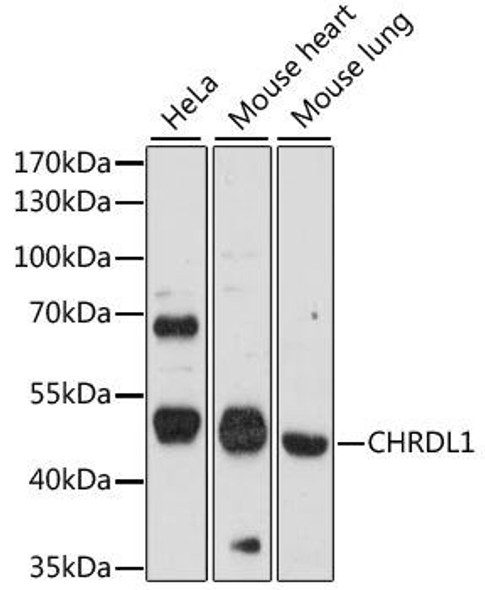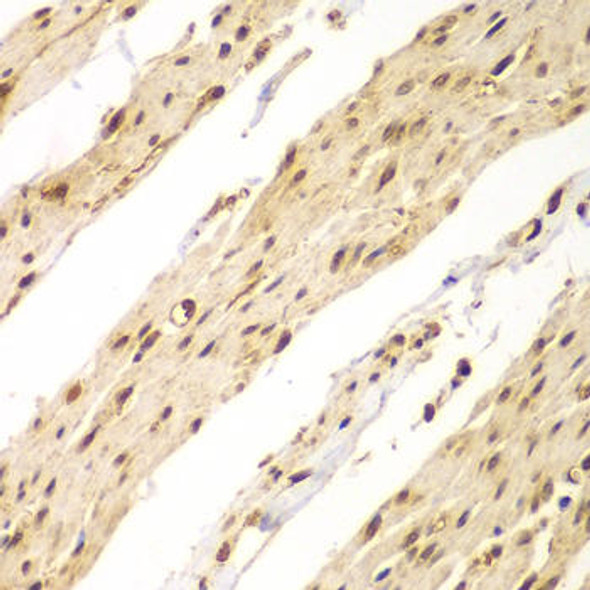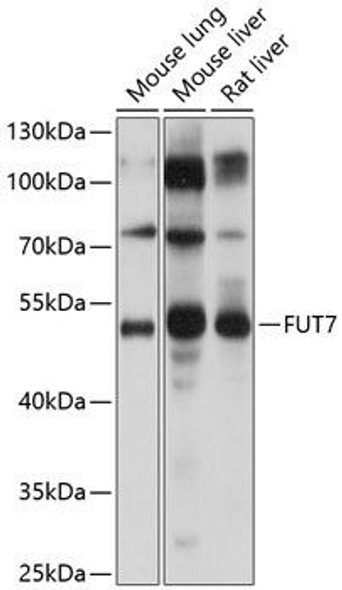Anti-FKBP52 Antibody (CAB4356)
- SKU:
- CAB4356
- Product type:
- Antibody
- Reactivity:
- Human
- Mouse
- Rat
- Host Species:
- Rabbit
- Isotype:
- IgG
- Research Area:
- Cell Biology
Frequently bought together:
Description
| Antibody Name: | Anti-FKBP52 Antibody |
| Antibody SKU: | CAB4356 |
| Antibody Size: | 20uL, 50uL, 100uL |
| Application: | WB IF |
| Reactivity: | Human, Mouse, Rat |
| Host Species: | Rabbit |
| Immunogen: | A synthesized peptide derived from human FKBP52 |
| Application: | WB IF |
| Recommended Dilution: | WB 1:500 - 1:2000 IF 1:50 - 1:200 |
| Reactivity: | Human, Mouse, Rat |
| Positive Samples: | 293T, Jurkat, Mouse testis, Mouse thymus, Rat testis |
| Immunogen: | A synthesized peptide derived from human FKBP52 |
| Purification Method: | Affinity purification |
| Storage Buffer: | Store at -20°C. Avoid freeze / thaw cycles. Buffer: PBS with 0.02% sodium azide, 0.05% BSA, 50% glycerol, pH7.3. |
| Isotype: | IgG |
| Sequence: | Email for sequence |
| Gene ID: | 2288 |
| Uniprot: | Q02790 |
| Cellular Location: | |
| Calculated MW: | 52kDa |
| Observed MW: | 56KDa |
| Synonyms: | FKBP51, FKBP52, FKBP59, HBI, Hsp56, PPIase, p52 |
| Background: | The protein encoded by this gene is a member of the immunophilin protein family, which play a role in immunoregulation and basic cellular processes involving protein folding and trafficking. This encoded protein is a cis-trans prolyl isomerase that binds to the immunosuppressants FK506 and rapamycin. It has high structural and functional similarity to FK506-binding protein 1A (FKBP1A), but unlike FKBP1A, this protein does not have immunosuppressant activity when complexed with FK506. It interacts with interferon regulatory factor-4 and plays an important role in immunoregulatory gene expression in B and T lymphocytes. This encoded protein is known to associate with phytanoyl-CoA alpha-hydroxylase. It can also associate with two heat shock proteins (hsp90 and hsp70) and thus may play a role in the intracellular trafficking of hetero-oligomeric forms of the steroid hormone receptors. This protein correlates strongly with adeno-associated virus type 2 vectors (AAV) resulting in a significant increase in AAV-mediated transgene expression in human cell lines. Thus this encoded protein is thought to have important implications for the optimal use of AAV vectors in human gene therapy. The human genome contains several non-transcribed pseudogenes similar to this gene. [provided by RefSeq, Sep 2008] |
| UniProt Protein Function: | FKBP4: Immunophilin protein with PPIase and co-chaperone activities. Component of unligated steroid receptors heterocomplexes through interaction with heat-shock protein 90 (HSP90). May play a role in the intracellular trafficking of heterooligomeric forms of steroid hormone receptors between cytoplasm and nuclear compartments. The isomerase activity controls neuronal growth cones via regulation of TRPC1 channel opening. Acts also as a regulator of microtubule dynamics by inhibiting MAPT/TAU ability to promote microtubule assembly. |
| UniProt Protein Details: | Protein type:EC 5.2.1.8; Chaperone; Isomerase Chromosomal Location of Human Ortholog: 12p13.33 Cellular Component: cytoplasm; cytosol; endoplasmic reticulum membrane; nucleoplasm Molecular Function:FK506 binding; heat shock protein binding; peptidyl-prolyl cis-trans isomerase activity; protein binding; protein binding, bridging Biological Process: negative regulation of microtubule polymerization or depolymerization; protein folding |
| NCBI Summary: | The protein encoded by this gene is a member of the immunophilin protein family, which play a role in immunoregulation and basic cellular processes involving protein folding and trafficking. This encoded protein is a cis-trans prolyl isomerase that binds to the immunosuppressants FK506 and rapamycin. It has high structural and functional similarity to FK506-binding protein 1A (FKBP1A), but unlike FKBP1A, this protein does not have immunosuppressant activity when complexed with FK506. It interacts with interferon regulatory factor-4 and plays an important role in immunoregulatory gene expression in B and T lymphocytes. This encoded protein is known to associate with phytanoyl-CoA alpha-hydroxylase. It can also associate with two heat shock proteins (hsp90 and hsp70) and thus may play a role in the intracellular trafficking of hetero-oligomeric forms of the steroid hormone receptors. This protein correlates strongly with adeno-associated virus type 2 vectors (AAV) resulting in a significant increase in AAV-mediated transgene expression in human cell lines. Thus this encoded protein is thought to have important implications for the optimal use of AAV vectors in human gene therapy. The human genome contains several non-transcribed pseudogenes similar to this gene. [provided by RefSeq, Sep 2008] |
| UniProt Code: | Q02790 |
| NCBI GenInfo Identifier: | 399866 |
| NCBI Gene ID: | 2288 |
| NCBI Accession: | Q02790.3 |
| UniProt Secondary Accession: | Q02790,Q9UCP1, Q9UCV7, D3DUQ1, |
| UniProt Related Accession: | Q02790 |
| Molecular Weight: | 51,805 Da |
| NCBI Full Name: | Peptidyl-prolyl cis-trans isomerase FKBP4 |
| NCBI Synonym Full Names: | FK506 binding protein 4 |
| NCBI Official Symbol: | FKBP4 |
| NCBI Official Synonym Symbols: | HBI; p52; Hsp56; FKBP51; FKBP52; FKBP59; PPIase |
| NCBI Protein Information: | peptidyl-prolyl cis-trans isomerase FKBP4 |
| UniProt Protein Name: | Peptidyl-prolyl cis-trans isomerase FKBP4 |
| UniProt Synonym Protein Names: | 51 kDa FK506-binding protein; FKBP51 |
| Protein Family: | Peptidyl-prolyl cis-trans isomerase |
| UniProt Gene Name: | FKBP4 |
| UniProt Entry Name: | FKBP4_HUMAN |










